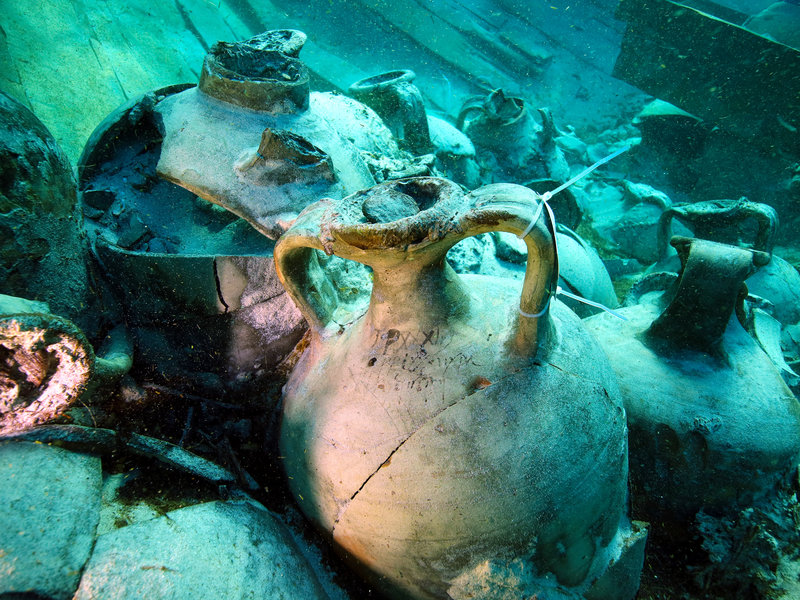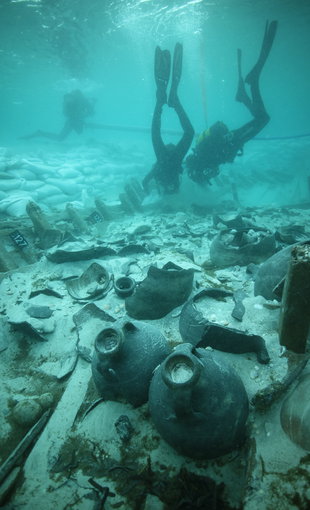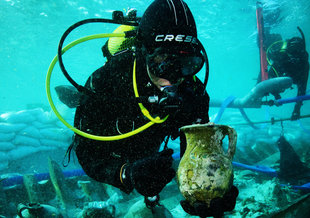17 centuries at the bottom of the sea
A fourth-century Roman ship found 50 metres from Ses Fontanelles beach in Palma is so well preserved that it will be extracted whole in a complex engineering operation
One morning in the spring of 2019, an amateur diver named Félix Alarcón went snorkelling off Ses Fontanelles beach in Mallorca and was surprised to see wooden pieces and amphorae sticking out of the sand below. Alarcón immediately notified the local authorities. Ses Fontanelles beach is in the Bay of Palma, about seven kilometres east of the capital of the Balearic Islands. It turned out that Alarcón had discovered the remains of an exceptionally well-preserved Roman ship, with a cargo of some 300 amphorae – the clay containers used in ancient times to transport goods. It is estimated that the ship had lain on the seabed since the 4th century.
How had no one ever noticed it before? What was it doing in a place where it would be more likely to find empty beer bottles from the millions of tourists who have summered in the area for years? A couple of kilometres away is Carrer de la Cervesa, a street known as the internationally famous Biergärten (beer garden in German).
“Tourists swam over the boat; it is 50 metres from S’Arenal beach, and two metres deep,” explains archaeologist Miguel Ángel Cau, co-director of the excavation. The fact that no one had seen it until then and its exceptional state of preservation is because until recently it was buried under the sand. “With climate change, there are more strong storms that are uncovering archaeological remains,” says professor Cau. “In the spring of 2019 there was a big maritime storm that may have had something to do with it.”
The island authorities, the Council of Mallorca, “carried out an initial examination of the site to assess the situation; they opened up the bow part and saw that the entire cargo was practically intact,” he adds.
A project was set up to carry out work on the site and an agreement signed between the Council of Mallorca, with Jaume Cardell from the University of the Balearic Islands in charge; the University of Barcelona (UB), through the Institute of Archeology and the UB’s Archaeological and Archeometric Research Team, headed by Cau; the University of Cadiz, with Professor Darío Bernal, and Professor Enrique García Riaza, also from the University of the Balearic Islands. Cau, who is a research professor at Icrea (the Catalan Institute for Research and Advanced Studies) and director of the Institute of Archeology of the UB (IAUB), co-directs the Arqueomallornauta project, with professors Bernal and García Riaza, and with Cardell.
It appears that the sunken vessel was a sailing boat that measured 16 metres long by five metres wide. Taking advantage that there was less tourism because of the pandemic, a second excavation was carried out between November 2021 and February this year. The researchers are now preparing a spectacular operation: extracting the entire ship so it can be studied, put through a process of restoration and displayed. The extraction is “exceptional”, nothing like it has ever been done in Spain, says Cau. “It’s a brutal engineering operation, they’re doing all sorts of mathematical calculations to see how it should be done.”
Cau explains that the ship “carried about 300 amphorae, many of which have painted inscriptions, called tituli picti, specifying the contents of the containers; it is an exceptional set of these inscriptions to be found in the Mediterranean.” Many of the amphorae were in fragments but there were others still intact. Some had shapes that had never been seen before. “We found amphorae still sealed and with the product inside: oil, wine, olives...” Some bear the inscription oleum dulcis (’soft oil’). Various objects and materials have also been found there: remnants of fabric, a leather shoe, a sandal…
Archaeology has changed a lot but thoroughly studying everything that has been found on the boat will nevertheless take years: “It will take a long time before the results come out”, says the archaeologist, whose office in the Faculty of History at the UB is full of samples. Studying such samples under a microscope allows the researchers to determine the place of origin of the materials in the amphorae. Such studies have ruled out the south coast of the Iberian Peninsula, where it was originally thought they had come from (and which is why the University of Cadiz was invited to take part in the project). “We have now deduced that it was a ship that left Cartagena [on the south-eastern Mediterranean coast] or a nearby port and ended up sinking in the Bay of Palma,” says Professor Cau.
Feature Archaeology






